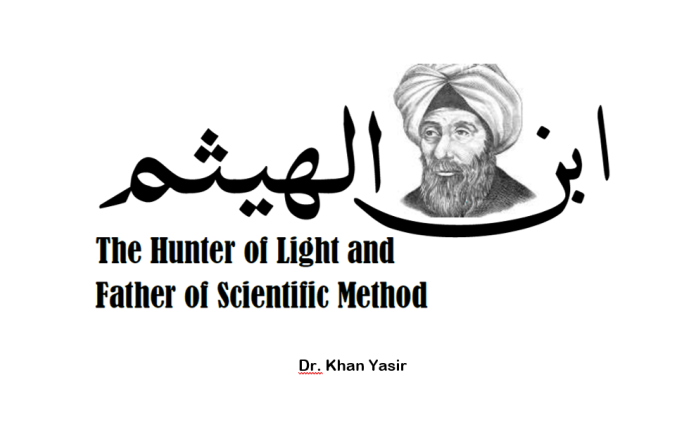– Dr. Khan Yasir
Open your eyes! If there is light, you are seeing the words before you. Your eyes, aided by light, serve as a gateway to the vast universe – blue sky, lush green grass, towering trees, roaring seas, the radiant sun, the luminous moon, the twinkling stars, and much more. Light is a marvel, not only for the beauty it reveals but also for its own fascinating nature. It moves at incredible speeds, travels in straight lines, yet bends and curves depending on the medium it encounters. It reflects, refracts, forms shadows, and captures images. Phenomena like rainbows and eclipses, which have captivated humanity for centuries, are all shaped by its properties. Even our own vision – the very act of seeing – remains a profound mystery. A great deal of these intriguing mysteries were unravelled by one man – Ibn al-Haytham. His ground-breaking research laid the foundation for the modern understanding of light, vision, and optics.
The medieval era – the golden age of Islamic sciences – produced numerous towering scholars, philosophers, scientists and polymaths. Among them was Ibn al-Haytham (965-1040 CE), whose contributions spanned multiple disciplines, including mathematics, physics, mechanics, astronomy, philosophy, and medicine. A prolific writer, he is known to have authored 96 books, of which 55 have survived. In a book, penned at least 13 years before his death, Ibn al-Haytham noted that he had already completed 25 works on mathematical sciences and 44 on physics, metaphysics, meteorology, and psychology – a testament to his relentless pursuit of knowledge and humongous scholarly output.
Among his many achievements, Ibn al-Haytham’s most revolutionary work was in optics, where he challenged, rather annihilated, ancient Greek theories with his keen observations and meticulous experiments and catalysed the development of the modern science of vision. His seminal work, the 7-Volume کتاب المناظر (Book of Optics), introduced the theory that vision occurs when light enters the eye, directly contradicting the long-held belief that the eye emits light to perceive objects. Through meticulous experimentation, he provided a scientific explanation of vision and reflection, discovered the laws of refraction and was the first to study and discern the dispersion of light into its component colours.
In short, his Book of Optics revolutionised the understanding of light and vision and, to put things into perspective, has been compared in its impact to Newton’s Principia Mathematica, marking a turning point in the study of physics and optics. His influence was so profound that the historian George Sarton, in his multi-volume encyclopaedic work Introduction to the History of Science, noted that many ideas attributed to Roger Bacon, Leonardo da Vinci, Francesco Maurolico, Giambattista Della Porta, and Johannes Kepler should, in fact, be credited to Ibn al-Haytham.
In his Book of Optics, Ibn al-Haytham systematically tested hypotheses, conducted controlled experiments, and insisted on verifiability and reproducibility – an approach that laid the foundation for the modern scientific method. He rejected blind acceptance of traditional theories; rigorously applied the scientific method (emphasising: observation, experimentation, logical reasoning, and replicability of results); and insisted that knowledge must be tested and verified through empirical evidence.
Ibn al-Haytham famously stated: “If learning the truth is the scientist’s goal, then he must make himself the enemy of all that he reads.” By this, he meant that a true student must critically analyse all knowledge rather than blindly accepting inherited wisdom. This approach deeply influenced modern European scientists and his rigorous methodology still remains foundational in modern scientific research from physics to medicine, where testing, objectivity, and analysis continue to drive progress and innovation.
This space is too limited to fully explore Ibn al-Haytham’s life and contributions, so let me enumerate five valuable lessons that students and aspiring scholars can learn from him:
Be curious: Ibn al-Haytham’s relentless pursuit of truth underscores the importance of curiosity in the quest for knowledge. A curious mind explores, discovers, and seeks deeper understanding. Wonder and curiosity are the first steps – without them, the journey towards knowledge and wisdom is impossible.
Ask questions: Ibn al-Haytham questioned established beliefs, which is the key to discovering truths. He read extensively, but rather than accepting ideas at face value, he critically analysed and challenged them. Truly, asking the right questions is the fuel that drives the pursuit of knowledge!
Observe and experiment: Ibn al-Haytham demonstrated that systematic experimentation, rather than assumptions or blind adherence to past authorities, leads to substantive knowledge. He investigated, tested, and sought answers through observation, research and experiment. Students should apply this problem-solving approach not only in their studies but also in real life.
Embrace interdisciplinary learning: Beyond optics, Ibn al-Haytham made significant advances in astronomy, mathematics, and physics. His work spanned multiple fields, emphasising the importance of diverse knowledge. For an in-depth understanding and holistic contributions, students should venture beyond their specialised disciplines and adopt an interdisciplinary approach.
Persevere in the face of challenges: One of the most inspiring aspects of Ibn al-Haytham’s life is his resilience in the face of adversity. Despite political and financial hardships, he remained committed to his intellectual pursuits. In fact, he wrote his monumental Book of Optics while being imprisoned (1011–1021 CE). It means that instead of letting incarceration and adversity break him, he turned hardships into an opportunity for deep reflection, producing one of history’s most influential scientific treatises. His perseverance is a powerful reminder that challenges should not clip our wings; rather, they must fuel our determination.
Ibn al-Haytham’s influence extends far beyond his times. His works, translated into Latin, shaped the ideas of leading Medieval and Renaissance thinkers, including Roger Bacon, René Descartes, and Christiaan Huygens. In the West, he became known as “Alhazen.” Today, his contributions are increasingly recognised. In honour of his legacy, craters on the Moon (the crater Alhazen) and an asteroid (59239 Alhazen) bear his name and stand as lasting tributes to his impact on science and humanity. The United Nations also commemorated his contributions by dedicating the International Year of Light in 2015 to his pioneering work in optics.
It is unfortunate that many Muslims remain unaware of the intellectual giants of yesteryears, like Ibn al-Haytham, whose contributions shaped the course of science and human knowledge. However, merely knowing about them is not enough; what truly matters is drawing inspiration from their intellect, discipline, and unyielding pursuit of truth. To honour their legacy, we must strive to embody their spirit of inquiry, excel in diverse fields, and contribute meaningfully to the modern world – just as they illuminated the medieval era with their ground-breaking advancements. May Allah bless us with inquisitiveness, diligence, patience, and persistence to uphold and advance this radiant intellectual legacy!




